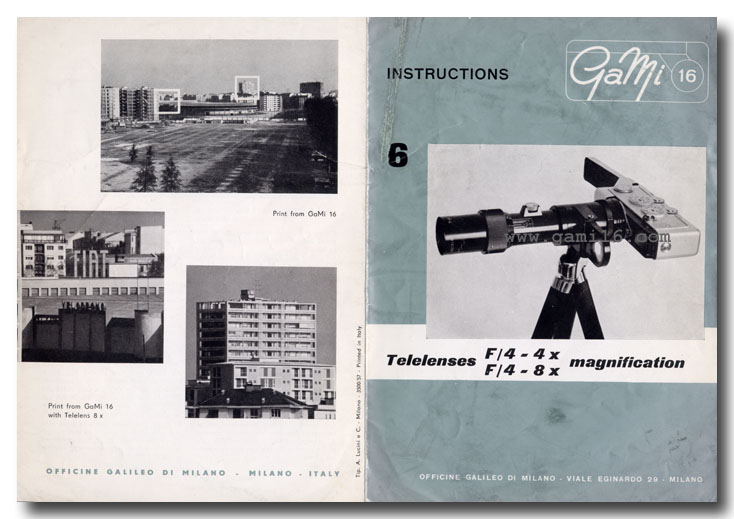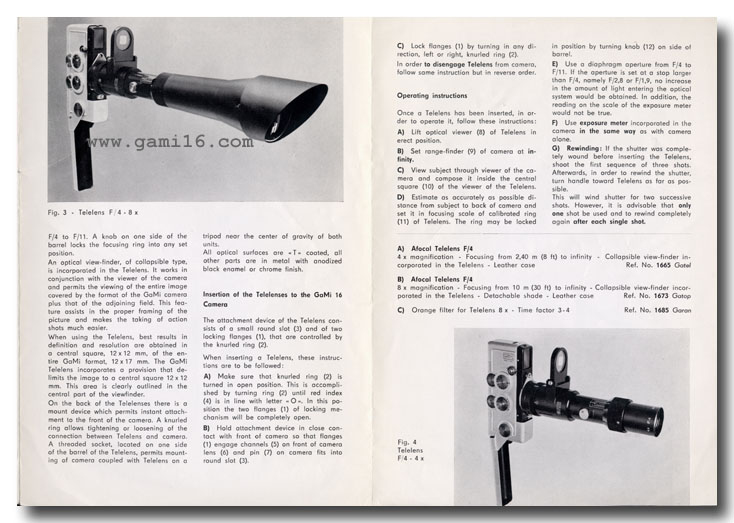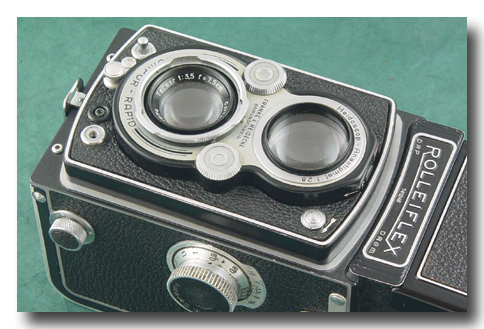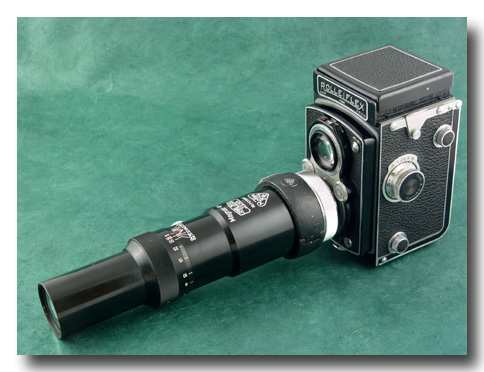
Telelenses 4x and 8x



The 4x and 8x telephoto auxilliary lenses are probably considered the most important accessories of GaMi16 system. The 4x telelens was the first to be put on the market. It was announced on the price list when the camera was launched in 1953. But was on sale only during the 1955. The 8x telelens was put on the market during the year 1957.

The 4x and 8x telelenses mounted on the GaMi16
An eminent inspiring ancestor...
The 4x telelens and consequently the more powerful 8x lens have an eminent inspirer. During March 1939 at Leipzig Trade Fair the Magnar Lens 4x was first displayed: it was an afocal telelens for Rolleiflex camera. The developer of this lens was attribuited to Carl Zeiss and the planning contribution of Reinold Heidecke, who, togheter with Paul Franke owned “Franke & Heidecke”, Rolleiflex’s producer. This telelens attachment was affixed to the “Type I” bayonet mount of the Tessar f/3.5 shooting lens.
Magnar 4x n.0000000 and its optical configuration

Magnar 4x (PR145) mounted on a Rolleiflex Standard with the tripod clamp (PR145/4)
From:.
C.Prochnow “Rollei Report I”
The
images have been kindly granted by Eng.
Claus Prochnow


One of the first advertisement of the Magnar 4x (March 1939)

Rollei Automat series two(PR071) 1938 with taking lens bayonet only

Rolleiflex Automat series two 1938 with Magnar 4x
It’s really interesting to note how Officine Galileo’s planning of the two GaMi telelens has been widely “inspired” by the Magnar 4x. The optical configuration, the overall general appearance, the components and some other project solutions are certainly due to a careful study of Magnar 4x by Galileo’s designers.
GaMi16 tele 4x an Carl Zeiss Magnar 4x
The Zeiss Magnar 4x and two GaMi’s telenses share a modification of the shooting field’s reduction, due to the smaller resolution quality on the edges. In the two GaMi16 telenses the frame’s surface was reduced to 12x12mm while in the Magnar even if the frame’s didn’t occur, Zeiss suggested using only a frame area of 30x30mm. For the presentation of the Zeiss Magnar at the Leipzig Fair, staff members were given some additional information “for their use only”:
With 6x6 cameras, the maximum speed is f/9, with 4x4 cameras f/7.3. Exposure should be “generous” (to be mentioned only on direct questioning). At full aperture, the 6x6 image will be sharp only over an area of 3x3, f/22 being required for sharpness right on the edges. In conjuction with a Rolleikin, "optimum sharpness" is guaranteed at any aperture.
An absolutely identical similarity of these two telelens is the focus’s lock which is built with the same fuctionality and aesthetic features.
The focus locking device are absolutely identical

The closest focus distance is 2.5 metres in both telenses
Less than 500 examples of Magnar4x were produced from March 1939 until July 1941. Some tests made with Magnar and GaMi telenses highlight that Galileo’s ones, thanks to more modern glasses and lens coating, manage to have better definition results, even at f/4 aperture.
On the other hand Magnar even with diaphragm f/22 doesn’t give any appreciable result. Maybe this was the reason why the production has never been resumed after the War.
GaMi16 Telenses and Magnar4x
Thanks to Eng. Claus Prochnow for his kind contribution
These two lenses were sold with a leather bag. The 4x bag was in soft brown leather with “Officine Galileo” impressed on the closing hem. The 8x bag was more beautiful because it was in rigid brown leather without Galileo’s logo.

The leather bag of GaMi 4x

The logo "Officine Galileo" on 4x bag

The bag of GaMi8x lens and the really rare metal hood
The variations of the two telelens are eight. The 4x and 8x have four versions. Distance scale in metric, in feet, with double scale: metric/feet in red/white color and white/white color. The very rare variant in metric/feet in withe/white is present only after the serial number 48000 on 8x and 4x. The firsts, really rare 8x, until serial number 25xxx has a metallic hood in aluminium 1mm thickness, painted in glossy black enamel outside and in flat black inside. From serial 26xxx to the end it has a plastic lens hood 2mm tickness in glossy black outside and in flat black inside.
If you like to send any information about GaMi16, please write to:
The reproduction is forbbidden without the authorization of www.gami16.com